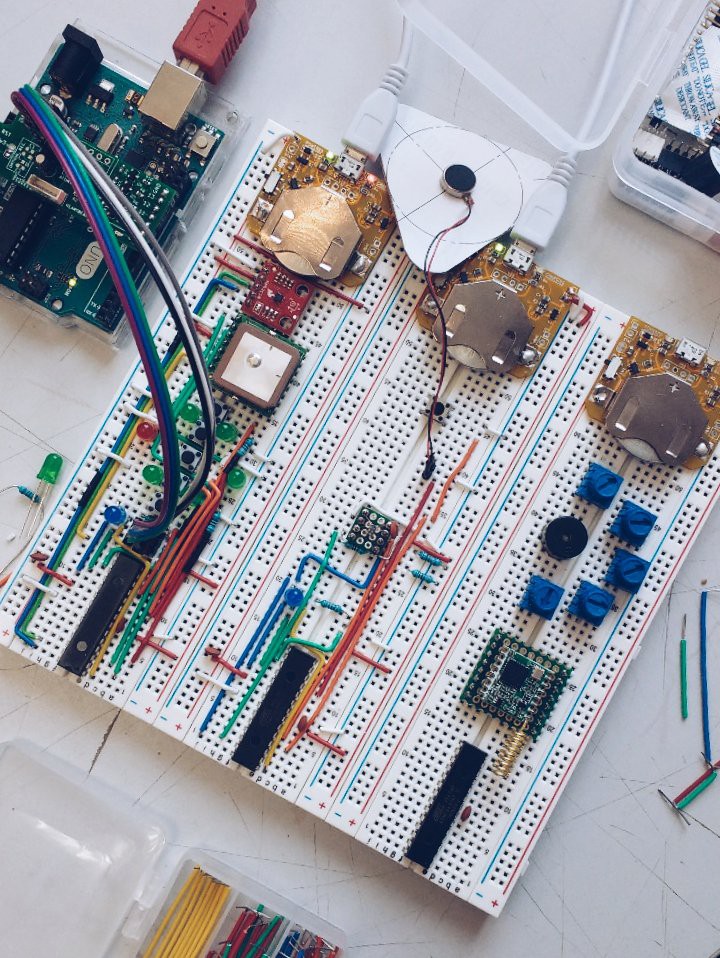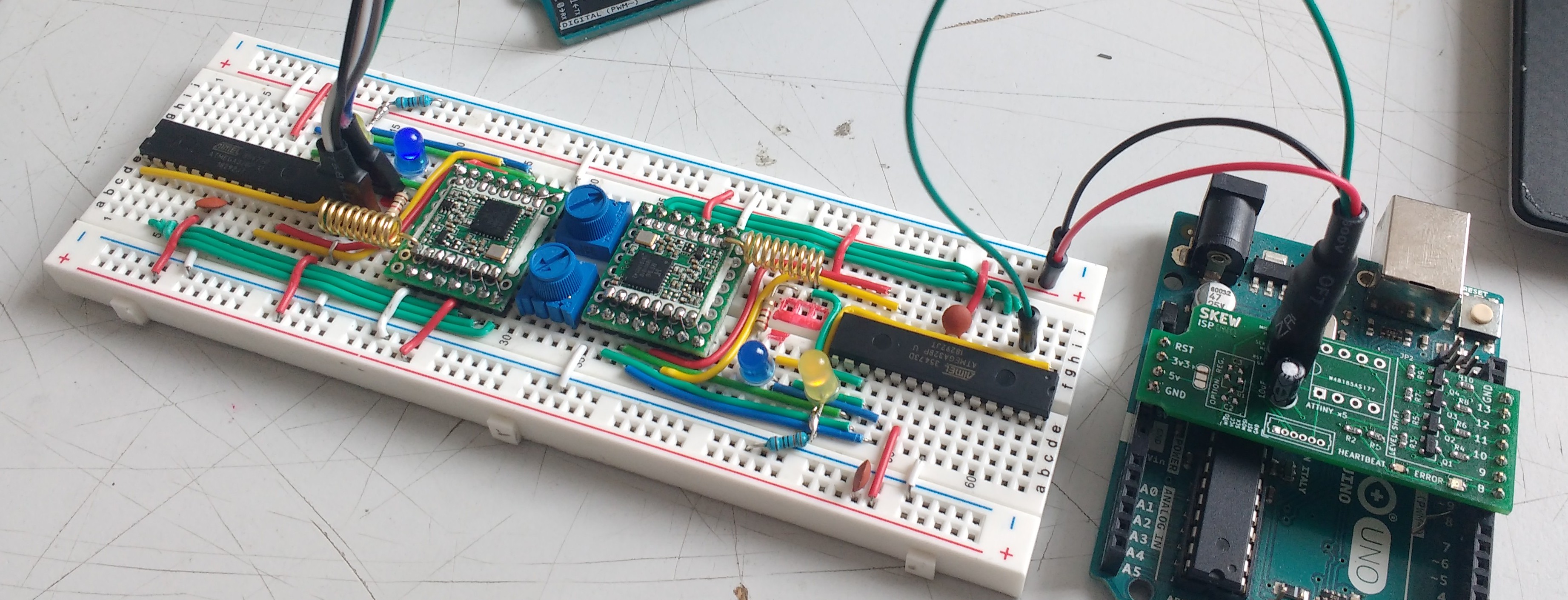-
Quickly prototyping my circuits
08/25/2019 at 12:36 • 0 commentsOnce I had the functionalities well defined for each of the three devices, I started to prototype, or more accurately, sketch each of my devices on breadboards. The firsts consisted just of cheap knock-of Arduinos with buttons, LEDs and the few specific actuators or sensors I needed. It was great to test each device in a controlled way. But I needed to be closer to an actual circuit that I could put on a PCB no bigger than a hand palm.
The next step was to get rid of the Arduinos and get instead a bare ATmega328. I redid my circuits using a mix of bare chips "dead-bugged" and breakout circuits from Adafruit, Sparkfun or NavSpark.
![]()
I also prototyped a charger circuit for the LiPo I wanted to use. This PCB conveniently fitted very well on the breadboards. You can get it on the this repo : LiPo Charger.
I tried to have an aesthetically satisfying cable management as I knew that I may have to show it here. I associated color with function : blue if for the clocks, yellow for reset, orange for interrupt sources, green for data, and red/white for power.
You can see that i glued my vibration motor to some cardboard to try to feel what a vibration would be like. I ended up cutting all my shapes onto cardboard to figure out an ideal shape for each device.
To flash the ATmegas, I remixed one of my previous projects : a Arduino UNO hat that breakout ISP signal with a proper voltage level shift. Indeed, I figured out that I needed to work at 3.3V instead of the standard 5V for classic Arduino boards. This ended up causing some problems, but thanks to that setup I could quickly figure out what went wrong.
One of the problems I had was that high speed SPI between one of my sensor and my MCU was not working. At the time I didn't know that the SPI bus was the cause of the malfunction. But a quick detour to an oscilloscope showed me that the signal was not reaching the high threshold. I figured that the pull-up resistors used by default on a Sparkfun break out were to large. This was an amazing learning opportunity as I was able to test multiple resistor values and immediately see the consequences on the signal.
I settled on a value of 1K. This may not be ideal, as it may increase power consumption of the whole device. But this is not the time for optimisation. This was the only oscilloscope of my school, but nobody used it, so I kept it. It saved me lots and lots of time in the development process (I returned it at the end of the semester =) ).
![]()
I finally did a dual one so I could work on the LoRa modules outside of the studio where all my project was. You can see that the hat I made was also used to get some power in and some UART serial out of the ATmegas to my computer for debug purposes.
With this setup, remixed several times to accommodate new sensors, I got a better idea of the real estate I needed from my PCBs and how small my devices could be. I ended up using those to develop the base of the my firmwares, as the electrical circuits should be no different from the PCB I draw and ordered.
With all the interfaces and sensors/actuators figured out, I was able to go to a mechanical validation phase. But that is for the next log !
Until next time,
be good !Antoine
-
Usage design
08/24/2019 at 13:08 • 0 commentsOn your phone, to access navigation you need to start an app, input your destination, chose a transport, chose an itinerary and then start the trip. That's around 8 taps from the home screen and some text input. That's a lot of actions. I want my devices to be really direct in their use.
To have this directness, I have to conceive very specialized devices instead of a generalist device (like a smartphone).
The interface must be simple, the functionality will also be simple. And this falls perfectly in my goals to build resilient devices.
One, button, one action
For the SABLIER I wanted to distance myself from other common devices that keep the time. I also wanted to design another perception of time. I came with this idea to notify the user every 15 minutes. I found that vibration was the less invasive way to achieve it. It is important for me that the user must be able the control the device : a single button will enable the user to start the device and control the moment of the first pulse. After 8 hours, the device will shut down.
With this behavior, the user is free to count the pulses or just feel it. The day is therefore divided by 3 ( 3 × 8h = 24h ). With some getting used to SABLIER, the user should be able to anticipate a pulse. SABLIER could be use to test one's perception of time.
It think the BOUSSOLE may be the most playful device of the 3. I always was frustrated that a compass only indicates the north and not the direction I wanted to go to. BOUSSOLE should be straightforward, you're in a place, you save it in the device, you go elsewhere, you recall this place with a single press of a button, you follow the direction shown be the device, you go to the place. One button, one place, one device, three places, I don't think we need more.
With that, you can save a place that serves as your base and you can start exploring, you can always return to your home, camp, AirBnB, friends flat. This device is meant for exploring, not productivity or efficiency. By only showing a direction, you have to choose your own path. Hopefully discovering some interesting things along the way.
SIFFLET is the most intimate. Due to the desire to have highly specialized devices, this one cannot serves all forms of communication. I chose to design this one to be only shared between significant others, or between a parent and its child. You can express a lot through music, I want to make SIFFLET a real instrument to show one's feeling. With an accelerometer I can modulate a sound and introduce rhythm only with movements. The accelerometer data is transmitted by a wireless connection to the other device and then modulated in a sound that the other user can hear and then respond in its own way. There will be only one button to start and stop the melody.
There was another version of this device in my original research. It used potentiometers to set 5 notes and a button to send it. It was not great because it was not direct. If you wanted to preview it I had to use another button on the thing and it was as "simple" as the other devices. So I found another way to generate music, and it was with the accelerometer.
One the next log I'll give you an overview of how I sketched the shapes and mechanically validated my designs.
Be good,
Antoine
-
Resilience
05/22/2019 at 13:51 • 0 commentsAn important element of my project is to develop very durable and resilient devices. Openness and minimalism are two of the main design features allowing these goals.
By opening the sources of my project, the three objects become reproducible and easy to repair. By simplifying its electronics and using affordable and well documented chips or modules, the repairability is even greater. These choices will influence the design of non-electronic parts as they also need to be durable and reproducible. The choice of material and its drawings will also be fondamental in order to convey durability and resilience.
As a consequence of these choices their experiences will also be very different from what we are used to:
The time-keeping device will not give you exact time. It gives an absolute sense of the passing of time by vibrating every 5 or 30 minutes.
The navigating device will not instruct you to go left or right. It will indicate the general direction of your destination, so that you can decide which path to take.
The communication device will not transmit text or voice. It will send small melodic messages.
A great attention will be given to senses and each device will provide specific sensorial stimuli: vibrations for touch, visual cues for sight and sound for hearing.
Each device resilient and independent from any global network or corporation. Finally, by being low-power, each device is freed from high level depedency from battery capacity.Next time, I'll detail the functionality of each device.
Until next time,
be good,
Antoine. -
Genesis
04/25/2019 at 09:16 • 0 commentsWelcome to this first log entry !
I started to work on this project a couple of months ago. It’s a self-initiated project that I'm developing in the framework of my degree in product design.
I was born with computers. I’ve always found it easy to work with different types of technology. That’s why I decided to develop a project in this field.When it comes to everyday use, I'm not convinced that the way we interact with technology is the best. I noticed that my daily consumption of tech can be limited to only two devices: my phone and my computer. They can satisfy all the tasks I need in my daily life : staying in touch with friends, work with partners, takings notes, quickly finding informations about anything, making calculations, navigating in a city, capturing memories, reminding us upcoming events, etc. They suit our needs when we have to be efficient but when we just want to relax and disconnect, they can become really intrusive.
![]()
illustration from the thelightphone project
---------- more ----------Social medias can be source of joy or excitement, but they can also trigger depression and anxiety. Youtube and Netflix are great to entertain us during our free time but don't you feel bad after a day of binge watching? I'm not the first one to experience these feelings. On top of that, platforms that we use everyday are designed to make us stay the longest time possible on their services, so that they perfectly know our behavior and our tastes. Platforms are today capable of proposing sophisticated tailored-made ads, pushing us buying our beloved stuff. To keep us online, they exploit some brain mechanics inherited from our pre-historic past. They play with our "Fear Of Missing Out" using notifications and likes to release dopamine or encouraging endless content creation. Sometimes they lead us to addiction. Theses usages of technology are like double edged swords: they can be useful but at the same time extremely harmful.
I have got a kind of hate-love relationship with my devices. I'm not calling for a total boycott, but information overload can definitely become a problem. And here I am, a guy with some knowledge of electronics. Maybe I can help.
I chose three features out of my phone daily use. Time keeping, navigation and communication. I then think of them as independent devices, keeping the same technology found in any phone. I take the threee features out of phone’s opaque plastic aesthetics. Some of them exist already as stand-alone devices: calculators, watches, walkmans, maps or GPS, etc. I need to bring something different in the mix.In the next logs I will describe in greater length my technology and design choices.
Until next time,
be good,
Antoine.
High-low tech: WATCH, GPS & PAGER
Want to ditch your smartphone but not its useful features ? 3 simple devices to use technology in a meaningful way //sine.stimu.lu/s
 Antoine Pintout
Antoine Pintout

